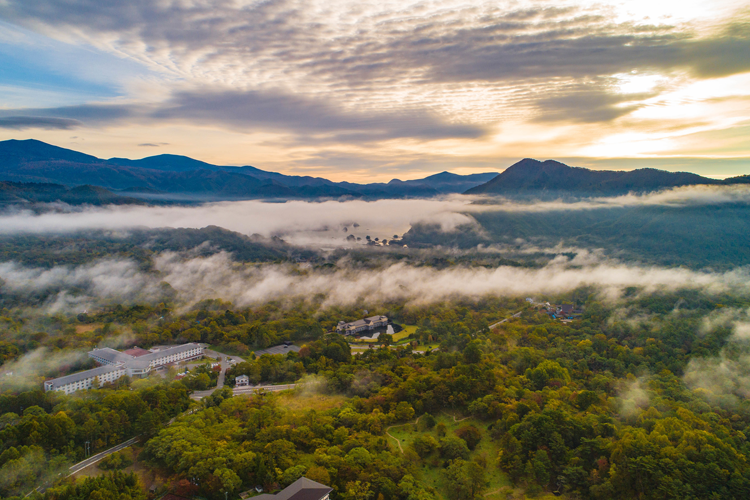
The plateau resort of Urabandai highlands is a place of outstanding natural beauty in Japan.
It is located in in northern Fukushima in the region of Tohoku. At the base of Mount Bandai is Kitashiobara-village, with an elevation of 800 m above sea level.
In addition to Mount Bandai which is one of 100 famous mountains in Japan, the region boasts Lake Hibara, Urabandai, Goshikinuma (five coloured ponds) and mysterious wetlands and clear streams.
Treasure mountain “Mt. Bandai”

Kitashiobara village is part of Bandai-Asahi National Park. The area has mountains full of green, rich flowing wetlands and a clean river.
The capital of this area is the treasure mountain, Mount Bandai.
The top of Mount Bandai seen from the northern side which shows the peak created by a phreatic explosion in 1888.
A rock slide stopped the river, creating hundreds of lakes and marshes. The group includes Goshikinuma, which is located between Lake Hibara, Lake Akimoto and Lake Onogawa.
Goshikinuma received a Michelin Green Guide 1 Star rating in 2016.
At Goshikinuma one can enjoy the colours of various lakes, magnificent scenery and hot springs. Mount Bandai helped create this treasure.
Originally, Mount Bandai (“Bandaisan” in Japanese) was called Iwahashiyama, which means “the ladder of a rock hanging over the sky”.
The northern side of Mount Bandai is called Urabandai. The southern side of Mount Bandai is called Omotebandai. Seen from Omotebandai, the mountain has one shape, but seen from Urabandai, the shape created by the violent explosion is more apparent. It was nominated in a selection of 100 Japanese geological features in 2007 and was authorised again by the Japanese Geoparks Network in 2011.
Constitution of Urabandai
On the 15 of July, 1888 (21st year of the Meiji Era), the great explosion of Mount Bandai led to the creation of a rough crater wall on the north side of Urabandai, and the cessation of the river due to the rock avalanches that flowed down at this time led to the creation of the Urabandai lake group, including Lake Hibara and Goshinuma. This was 20 years after the Boshin War (also known as the Japanese Revolution).
The river was dammed up, and the area’s biggest lake, Lake Hibara, was born. It took approximately two years after the eruption to become a big lake.
The scenery of Urabandai turns fresh green in spring, dark green in summer, red in autumn and silver in winter. Urabandai became known as Bandai-Asahi National Park in 1950.
In Urabandai one can feel the splendour of nature.

One visitor said, “Wherever you take a picture, the scenery that you see with your own eyes is completely different from what you feel in photos.” Over 130 years after the eruption, the power that nature has regenerated has become more and more abundant and spectacular.
In addition to what you experience of the topography and bare rock, various animals and plants live in Urabandai.
Wildlife is rarely seen during the day, but in winter the footprints of animals remain on the snow at dawn, and you will experience the symbiosis not only in the forest, but also in front of the sidewalks and houses. Also, Urabandai is recognised as an Important Bird Area (IBA) by international standards. There are many kinds of wild birds because of various habitats from the waterside to the sub-alpine zone. Thanks to the abundance of nature, there is much to experience in the greener seasons as well as winter.

Urabandai is the perfect place for people who like to get back to nature. If you’re more of a city person who doesn’t make it out to the countryside very often, we hope that you’ll consider Urabandai for those few times that you do.
This place gives a superb view of Urabandai.
The activities of Urabandai can be seen.
Access to Urabandai